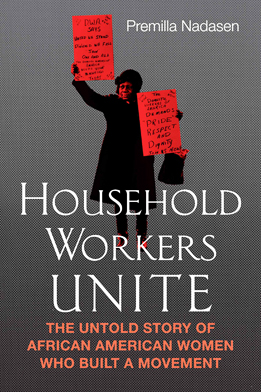|
Household
Workers Unite
by Premilla Nadasen
c.2015, Beacon Press
$27.95 / $33.00 Canada
248 pages
By Terri Schlichenmeyer
The Truth Contributor
There is not a speck of dust in your home.
The floors gleam, the kitchen shines, the bathroom sparkles,
and rugs are fluffy again. You’ve changed bedsheets and you
even washed windows. You’re ready for fall and thankful for
the help you had getting this way; if that help was paid,
read Household Workers Unite by Premilla Nadasen,
and you’ll be thankful for even more.
|
 |
|
Picture this: a white reporter encourages African-American
maids to “speak out about their hardship” and the women who
employ them. You know the movie, but did you recognize the
“victimization theme?” Yes, says Nadasen, The Help
“reinforces dominant stereotypes of passive household
workers,” even though there was historically nothing passive
about them…
In the years following the Civil War, the “Mammy” figure
took hold in white America, becoming somewhat of a cult
based on the idea of a loyal, maternal female slave. That
vestige of slavery (and inherent racism) generally affected
how African-American domestic workers were treated by white
female employers then, but “new ideas were germinating.”
In 1881, black laundresses formed a “Washing Society” and
eventually went on strike for higher wages. Activism never
stopped, but there was a setback in the fledgling movement
during the Depression, when black domestics found day-work
by sitting in a street corner “slave market,” and that
didn’t go unnoticed. By 1934, journalists, activists, and
other black feminists threw their support behind Dora Jones,
who led the Domestic Workers Union (founded in 1934) in New
York.
Nurse, midwife, and housekeeper Georgia Gilmore used her
cooking skills to raise money for “The Club from Nowhere,” a
group supporting activists and organizers both financially
and with food. Undoubtedly, the Civil Rights Movement
spurred Atlanta’s Dorothy Bolden to work with Dr. King on
behalf of household workers. Cleveland’s Geraldine Roberts
founded the Domestic Workers of America. Edith Barksdale
Sloan pushed the movement along when she became head of the
National Committee on Household Employment. Other
influential women bore their share of the movement, just as
today’s activists help protect the workplace rights of
caregivers, personal helpers, and domestic workers of all
races.
Imagine seeing a federally-funded monument to the “black
mammy,” standing in our nation’s capital. Yep, in 1924, the
United Daughters of the Confederacy tried to build exactly
that, and it was “furiously opposed.”
That’s just one of the stories you’ll read inside
Household Workers Unite.
Stories, says author Premilla Nadasen, are what she tried to
fill her book with, in fact, and she somewhat succeeds.
There are, indeed, a lot of stories here, but there’s plenty
of dryness, too, in the form of names, dates, and acronyms
that ultimately become quite overwhelming. My advice is to
try and get through them; this book is powerful and
inspiring, but the voices and their memories are what
matters.
This isn’t your curl-up-in-front-of-a-fireplace kind of read
but it is a pleasure, especially if you’re a historian,
feminist, or domestic worker yourself. Household Workers
Unite will make you think as it eats up every speck of
your time.
|